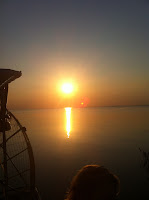Our next three posts will showcase three more essays by students in the Pilot class of the Loyola Intensive English Program. Pilot students are preparing for full academic admission to Loyola University New Orleans by taking two credit-bearing intensive English courses and two other academic courses at Loyola.
For
this assignment, our Pilot Writing & Grammar class was asked to
describe a particular place in or near New Orleans in such a way as
to capture the spirit of that place. This assignment goes beyond simple
description, asking for an examination of the deeper feelings or spirit
that the place evokes. Each essay is accompanied by photos.
 |
| Meng Li of China |
Our first essay is by Meng Li of China, a finance major at Loyola. Meng plans to use her business studies at Loyola University New Orleans to pursue a career in banking in her home country.
Meng has chosen to describe the Sydney and Walda Besthoff Sculpture Garden in New Orleans' City Park. Meng highlights three particularly striking sculptures. She vividly desribes each one and delves into the feelings and thoughts that each sculpture evokes.
The Besthoff Sculpture
Garden
By Meng Li
The
Sydney and Walda Besthoff Sculpture Garden, opened in 2003, can really be viewed
as a paradise for visitors to our city who love culture and treasure the arts.
It is located behind the New Orleans Museum of Art in New Orleans’ City Park.
More than fifty amazing and priceless sculptures are scattered on the lawns of
the garden.
I have
visited the garden only once and it left on me an unforgettable impression.
That day was an excellent sunny day. Many visitors came there, and I was one of
them. I saw that many oak trees were planted on the lawn; the grass had been
mowed neatly and looked very green and beautiful under the sun. The birds were
flying across the blue clear sky. Some people were taking pictures with the attractive
statues, talking about the nice scenery, and reading the detailed descriptions
of the statues. The warmth of the sun and the fresh air made me feel relaxed
and comfortable.
The
sculptures were arranged very well and excellently decorated the garden. I like
one of the sculptures best: a black huge metal spider about two meters high. A
large body sits atop the long and thin legs. Its feet look like needles inserting
into the lawn and forming a giant circle which could even contain thirty people.
Seeing it from a far distance, it's just a big common spider, but when you
stand under it, you will realize how tiny you are and how scary it is. It’s
facing towards the ground, and its giant curved belly makes me think of a black
widow spider who just ate her husband. When I touched it, I found that my hands
even couldn’t hold its leg, and I was too short to touch its body. It made me
remember some very cool and splendid scenes of sci-fi movies as well, such as where
some anomalous extraterrestrial creatures invaded our land, or where scientists
created some kind of new chemical that could make insects grow bigger and
stronger to help us fight against aliens, or where people polluted the
environment beyond the capacity of the earth to recover, resulting eventually in
gene mutation of animals.
 |
| Spider Sculpture |
Another
one that made me marvel was a humanoid sculpture. It was hollow and made of
alphabet-shaped silver-colored metal pieces; it was positioned like a man who
puts his arms around his legs sitting on the grass. He was not only shiny under
the sun and appeared very beautiful, but also the interlocking metal alphabet
letters made him transparent. I was thinking about the feeling that the
sculptor was trying to express, while I was looking at this sculpture. Maybe
the sculptor wanted to let us remember that our life is made more wonderful and
complete because of language. Those twenty-six alphabet letters make up
hundreds of thousands of different words that enable us to communicate with
each other, write down our thoughts, or express our feelings. However, the answer will be different for
different people, and the question could never have a certain answer. That is
one of the sculpture’s charms, I think. It can enrich our imaginations and bring
us a lot of fun. I saw many people stop at this sculpture and take pictures
because it was amazing and glorious under the sun.
 |
| Humanoid Sculpture |
When I
walked even deeper, I saw a sculpture which was formed using a lot of
violin-shaped metal pieces assembled into a tall violin tower, located on the
water. I couldn't clearly count how many metal violins were fused together, but
I knew that the sculpture was about two and a half meters high. I was wondering
why it was placed on the water instead of elsewhere. I imagined it on a lawn or
other places, but no place could be better than the water surface because I
could imagine the violin tower as a musical tornado whipped up by the sea. What's more, a bridge was visible in
the distance. Many ducks were swimming around the violin tower. This view was
nothing but beautiful because the whole scenery was as gorgeous as if it were
painted.
 |
| Violin Sculpture |
If people
who love the arts are given a chance to come to the Sydney and Walda Besthoff Sculpture
Garden, I bet they will like this wonderful place as I do. Every sculpture in
this garden is a masterpiece.
* * *
Our thanks to Meng Li of China for this thoughtful and evocative description of the Sydney and Walda Besthoff Sculpture Garden.
Our next post will showcase an essay by Xiang "James" Zhang of China, who describes his recent airboat trip on nearby Lake Salvador and provides interesting tid-bits of information about the alligators he encountered.



















